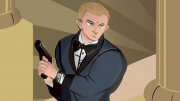Audiences will undoubtedly be depressed while watching Spike Jonze’s Where the Wild Things Are. But this kind of mood is rare and refreshing when we consider the fact that it is targeted towards younger audiences.
The Land Before Time and An American Tail, two ‘80s animated films directed by Don Bluth kept re-surfacing in my mind while I watched the film. If memory serves me right, those two films had a major impact on me when I was young. I’m not sure if Where the Wild Things Are is going to have as big of an impact on its demographic, but I can’t recall a kid flick released in the past five years that goes out of its way to create a more morose sense of self.
The film traverses a lesser-traveled depiction of the fragility of being a child. The film is erratic with its moods and tantrums, reflecting the mentality of the film’s protagonist, Max (Max Records). It captures the traumatic elements of his life with so much realism that it succeeds in capturing a child’s angst. Indeed, the film has the audacity to depict the world as not ideal, even as created in a young child’s subconscious. The wild things are created in Max’s mind to allow him see his mother’s (Catherine Keener) perspective on their uncompromising relationship. In his new world, Max is his mother (the land’s caregiver) and the lead wild thing, Carol (voiced by James Gandolfini), is Max. The wild things are just as unhappy, ignorant and morose as Max. It shouldn’t take long before viewers understand that Max’s appearance in the world of the wild things will change their circumstance. And, much like the circumstance in Max’s family, the change will be negative.
There is a lot to be said for Where the Wild Things Are. It has a great visual flair. Indeed, Jonze’s direction creates a world unlike any I have ever seen. I love the film’s sudden change of landscapes, capturing the unlimited boundaries of a child’s imagination. The film’s cinematography by Lance Accord (Lost In Translation) is gorgeous, breathtaking and electric. The costuming, supplied by Jim Henson productions, is a standout in the film’s fine production design.
Perhaps the film’s biggest enabler, though, is its screenplay written by Jonze and author Dave Eggers. It’s first half smote me, specifically in the way it dealt with the wild things’ initial appearance. I enjoyed their cutesy dialogue and the way they were honest about their insecurities. The scenes shared between Records and Gandolfini are particularly strong. However, the film takes a turn in the second half and becomes a broken record. Scenes play out one after another with the same tone and situations. Nothing new comes up and the final act lacks the emotional weight that it is entitled to. The film concludes on a note that makes one wonder if it was actually just a draft away from being an unqualified success.
★★★.5 out ★★★★★



